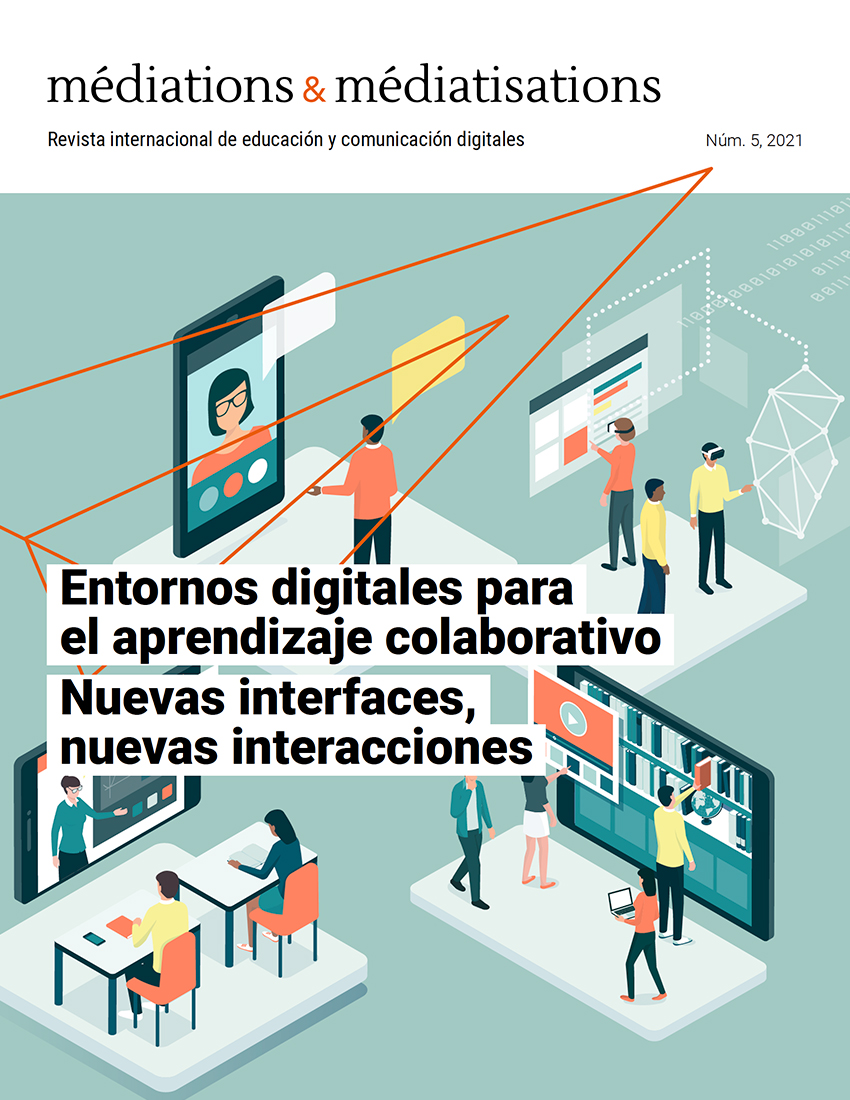Herramientas numéricas para apoyar los procesos de regulación en una comunidad de codesarrollo de conocimiento
Contenido principal del artículo
Resumen
Como parte de un curso de postgrado universitario, seis estudiantes de educación desarrollaron conjuntamente el tema de la equidad digital en el entorno en línea y presencial utilizando el Foro de Conocimiento y Google Drive. Tras esta experiencia, surgió la pregunta siguiente: ¿cómo podemos maximizar el funcionamiento de una comunidad híbrida de codesarrollo de conocimiento para favorecer la cocreación de dicho conocimiento? Las recomendaciones resultantes de este análisis se refieren a los diferentes procesos de regulación, a las ventajas de las herramientas digitales y a las influencias mutuas de los contextos de codesarrollo. Por último, se propondrán dos herramientas digitales para facilitar una regulación compartida en la comunidad.
Descargas
Detalles del artículo
Citas
Allaire, S. et Lusignan, G. (2011). Enseigner et apprendre en réseau : collaborer entre écoles distantes à l’aide des TIC. Anjou : Éditions CEC.
Belland, B. R. (2014). Scaffolding: Definition, Current Debates, and Future Directions. Dans J. M. Spector, M. D. Merill, J. Elen et M. J. Bishop (dir.), Handbook of Research on Educational Communications and Technology (4e éd., p. 505-518). New York : Springer.
Bereiter, C. et Scardamalia, M. (2003). Learning to work creatively with knowledge. Dans E. De Corte, L. Verschaffel, N. Entwistle et J. van Merriënboer (dir.), Unravelling basic components and dimensions of powerful learning environments. EARLI Advances in Learning and Instruction Series (p. 55-68). Oxford, UK: Elsevier Science.
Brennan, K. (2012). Best of both worlds: Issues of structure and agency in computational creation, in and out of school (thèse de doctorat). Massachusetts Institute of Technology, Cambridge, MA.
Côté, D., Dubé, J. et Arsenault, M. (2020). L’approche ethnographique : illustration dans un contexte de réadaptation au travail. Dans M. Corbière et N. Larivière (dir.), Méthodes qualitatives, quantitatives et mixtes (2e éd., p. 59-88). Québec : Presses de l’Université du Québec.
Hutchison, A. et J. Colwell, J. (2012). Using a wiki to facilitate an online professional learning community for induction and mentoring teachers. Education and Information Technologies 17(3), 273-289. https://doi.org/10.1007/s10639-011-9159-7
Järvelä, S. et Hadwin, A. F. (2013). New Frontiers: Regulating Learning in CSCL. Educational Psychologist, 48(1), 25-39.
Jézégou, A. (2015). Diriger soi-même ses activités d'apprentissage par et dans un Mooc de type connectiviste. International Journal of E-Learning & Distance Education, 30(1). http://www.ijede.ca/index.php/jde/article/view/868/1574
Laferrière, T. (2005). Les communautés d’apprenants en réseau au bénéfice de l’éducation, Encounters on Education, 6, 5-21. https://qspace.library.queensu.ca/bitstream/1974/480/1/art%201%20laferriere.pdf
Laferrière, T. (2015). TEN-7000 : Apprentissage en réseau. Plan de cours inédit, Université Laval.
Martel, V. (2005). Émergence d'une communauté d'apprentissage en réseau à l'ordre primaire: l'activité de transformation d'un environnement d'apprentissage par la direction, les enseignants et les élèves (étude de cas) [thèse de doctorat inédite]. Université Laval, Québec, Canada.
Scardamalia, M. (2002). Collective cognitive responsability for the advancement of knowledge. Dans B. Smith (Ed.), Liberal Education in a Knowledge Society (p. 67-98). Peru, ILOpen Court. http://ikit.org/fulltext/2002CollectiveCog.pdf.
Scardamalia, M. et Bereiter, C. (1999). Schools as knowledge building organizations. Dans D. Keating et C. Hertzman (dir.), Today’s children, tomorrow’s society: The developmental health and wealth of nations (p. 274-289). New York: Guilford.
Scardamalia, M., et Bereiter, C. (2003). Knowledge Building. Dans J. W. Guthrie (dir.), Encyclopedia of Education (2e éd., p. 1370-1373). New York : Macmillan Reference, USA.
Stone Wiske, M. (1998). Teaching for understanding: Linking research with practice. San Francisco: Jossey-Bass Publishers.
Tremblay, M. et Dion-Routhier, J. (2018). Coélaboration de connaissances sur les facteurs d’engagement à une communauté de pratique pour le DP (CoDP). McGill Journal of Education/Revue des sciences de l’éducation de McGill, 53(3).
Winne, P. et Hadwin, A. (2008). The weave of motivation and self-regulated learning. Dans D. Schunk et B. Zimmerman (dir.), Motivation and self-regulated learning (p. 297-314). New York : LawrenceErlbaum.
Zhang, J., Scardamalia, M., Lamon, M., Messina, R. et Reeve, R. (2007). Socio-cognitive dynamics of knowledge building in the work of 9- and 10-year-olds. Educational Technology Research and Development, 55(2), 117-145. https://doi.org/10.1007/s11423-006-9019-0
Zimmerman, B. J. (1990). Self-regulated learning and academic achievement: An overview. Educational Psychologist, 25(1), 3-17.
Zimmerman, B. J. (2008). Goal Setting: A Key Proactive Source of Academic Self-Regulation*. Dans D. H. Schunk et B. J. Zimmerman (dir.), Motivation and self-regulated learning: Theory, Research, and applications (p. 267-295). New York, New York, USA: Lawrence Erlbaum Associates.

